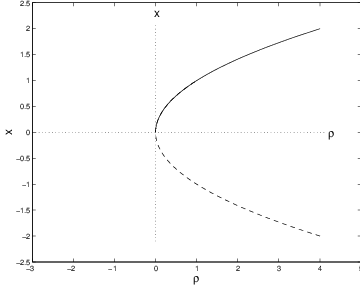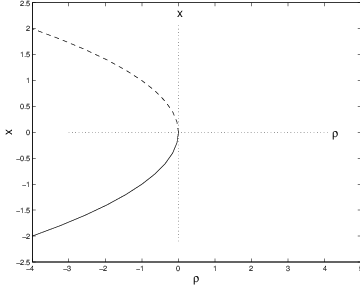The simplest steady-state bifurcations — and the ones that are most likely to occur — are the saddle-node bifurcations. In Section ?? we found necessary conditions for the existence of saddle-node bifurcations in one dimension (??) and two dimensions (??). In this section we describe necessary and sufficient conditions for the existence of saddle-node bifurcations.
Saddle-Node Bifurcation in One Dimension
Consider the differential equation
that depends on the single parameter . The equilibria are found by solving the algebraic equation We can study how the equilibria in phase portraits for (??) change when is varied by plotting solutions to (??) in the -plane. The solutions to (??) form the bifurcation diagram of (??).Recall from (??) that
are necessary conditions for a saddle-node bifurcation to occur at . The simplest example of a saddle-node bifurcation is: where is a nonzero constant. The exact bifurcation diagram for (??) depends on the sign of . See Figure ??. Note that the bifurcation diagram is just a parabola pointing either to the left or to the right. The general saddle-node bifurcation is one whose bifurcation diagram looks ‘parabolic-like’. Theorem ?? makes this idea precise.
- Proof
- The proof of this theorem uses the implicit function theorem and implicit
differentiation. (Technically, we need to assume that the second derivatives of are
continuous before proceeding.) Since is assumed to be nonzero, the implicit
function theorem guarantees the existence of a function such that and
for all near . It follows that the bifurcation diagram is the graph . We claim that
and . Thus the Taylor series of the function is for all near . It follows that the
bifurcation diagram is parabolic in shape as in Figure ?? — opening either to the
left or to the right depending on the sign of .
We use implicit differentiation to verify these claims. Differentiating (??) twice yields
andEvaluating (??) at yields Since, by assumption, and , it follows that Evaluating (??) at now yields The nondegeneracy assumptions (??) imply Thus . So when the number is negative and the bifurcating branch is supercritical, as in Figure ??. Similarly, when the number is positive and the bifurcating branch is subcritical.
An Example of a One Dimensional Saddle-Node Bifurcation
Consider the following example of a saddle-node bifurcation. Let
A quick check shows that is an equilibrium for (??) when . Moreover, It follows from Theorem ?? that has a saddle-node bifurcation when at . Indeed, since , it follows that there are two equilibria near when and none when . See Figure ??. This fact can be verified using pline. When is small and positive, there is one stable equilibrium near . When is small and negative, there are three equilibria — the stable one near and two new equilibria near formed from the saddle-node bifurcation.Saddle-Node Bifurcations in Two Dimensions
In higher dimensions, steady-state bifurcations occur at parameter values where the Jacobian matrix has a zero eigenvalue. In one dimension, the Jacobian matrix is the number . Such a Jacobian matrix has a zero eigenvalue precisely when vanishes — which is just the condition in (??).
In two dimensions, the Jacobian matrix is a saddle-node matrix when it has a single zero eigenvalue, that is, when and . Now consider the planar system of differential equations depending on a parameter . We write this system as
where and in coordinates. Sufficient conditions for the existence of a saddle-node bifurcation in (??) are as follows.- (a)
- Equation (??) has an equilibrium at ; so
- (b)
- The Jacobian matrix has a zero eigenvalue and a nonzero eigenvalue. Let be a nonzero vector in the null space of . Assume where . (In one dimension, (??) just states that is nonzero; that is, the first nondegeneracy condition in (??) is valid.)
- (c)
- Let be a nonzero vector in the null space of . The following is an analogue in two dimensions for the second nondegeneracy condition in (??), . Define to be the vector evaluated at . The nondegeneracy condition in two dimensions is:
A steady-state bifurcation is a saddle-node bifurcation if (??) and (??) are valid. At a saddle-node bifurcation two equilibria coalesce as is varied, and the bifurcation diagram resembles that in Figure ??.
An Example of a Two Dimensional Saddle-Node Bifurcation
As an example, consider the system of differential equations
analytically. Draw the bifurcation diagram.
